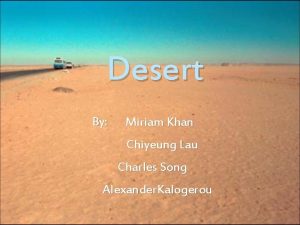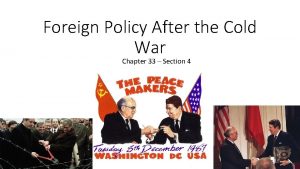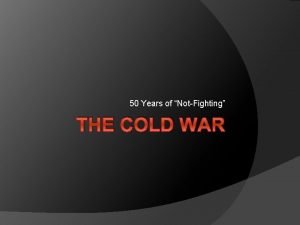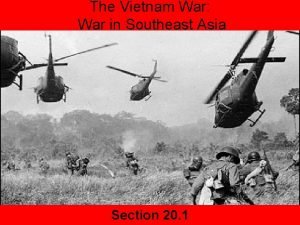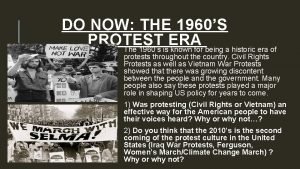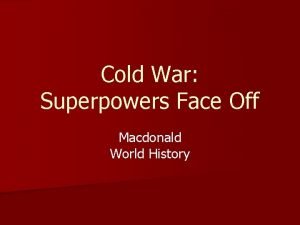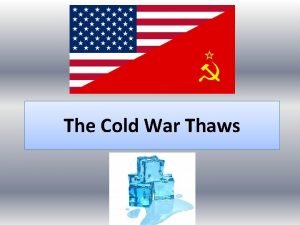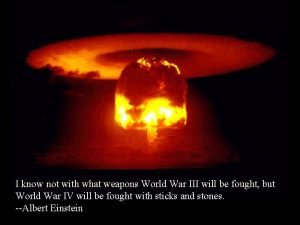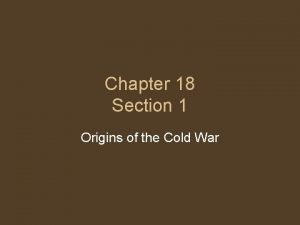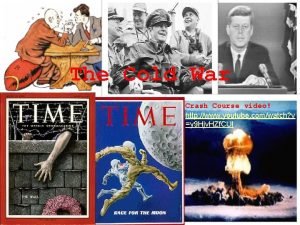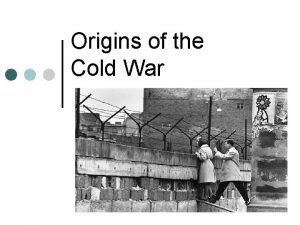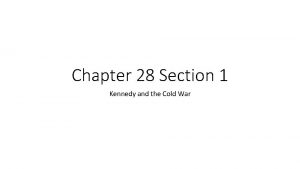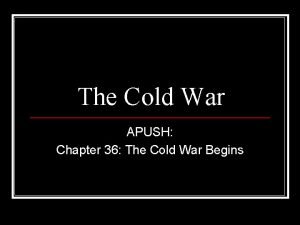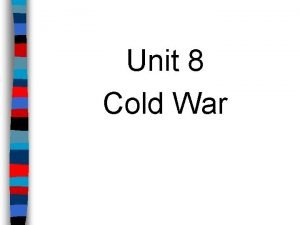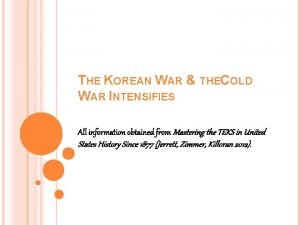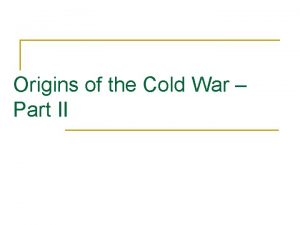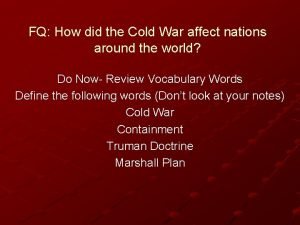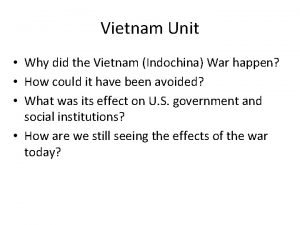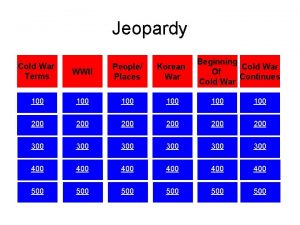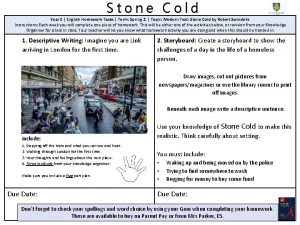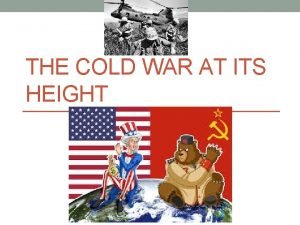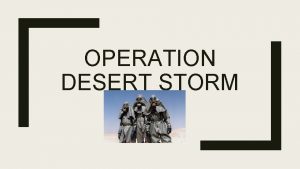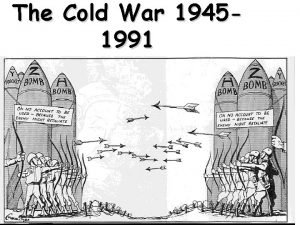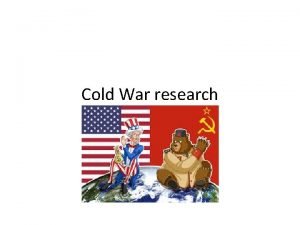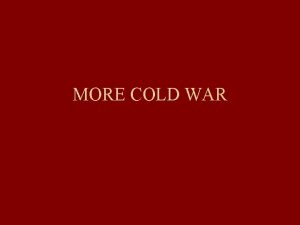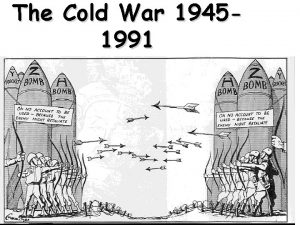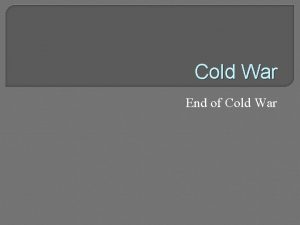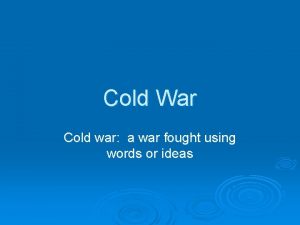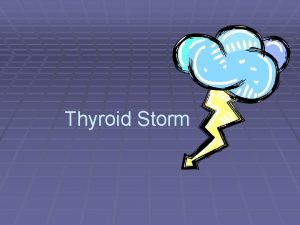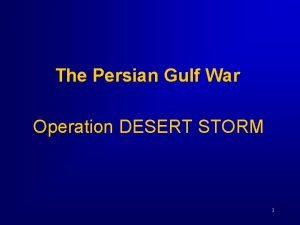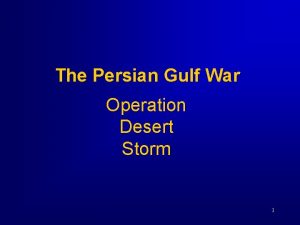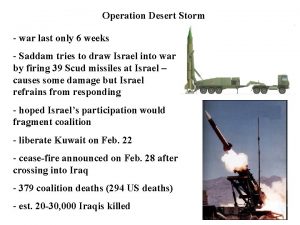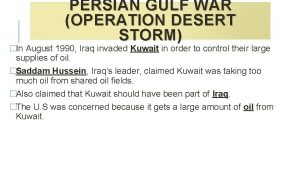The End of the Cold War Desert Storm
































- Slides: 32

The End of the Cold War, Desert Storm, and the New World Order Theme: The US emerges as the world’s only superpower Lesson 24

President Reagan • During the 1980 s, Cold War tensions increased as Ronald Reagan pursued a vigorous anti. Soviet policy – Characterized the Soviet Union as “the evil empire” – Dedicated massive amounts of money to military spending to include the Strategic Defense Initiative or “Star Wars” – Successfully confronted communist challenges in Grenada and Nicaragua Reagan delivers his “Mr. Gorbachev, Tear Down This Wall!” speech in 1987

The Soviet Union • While the US was spending at levels the USSR was finding difficult to match, the Soviets were having their own internal problems – The Soviets withdrew from Afghanistan in 1989 after ten years of a failed war many likened to the US experience in Vietnam – The Soviet economy and those of its eastern and central European satellites were in serious trouble US-supplied Stinger missiles helped the mujahedeen defeat Soviet forces in Afghanistan

Gorbachev • With economic and political reforms obviously needed, Soviet premier Mikhail Gorbachev initiated perestroika (the “restructuring” or decentralizing of the economy) and glasnost (an “opening” of the Soviet society to public scrutiny) • Gorbachev’s reforms proved difficult to implement and unleashed hostility from the old order it threatened, long suppressed criticism, and ethnic and nationalist separatism • By the summer of 1990, Gorbachev’s reforms had spent themselves

Collapse of the Soviet Empire • Revolutions broke out throughout eastern Europe as people overthrow communist dictators in places like Poland, Bulgaria, and Romania and countries such as Czechoslovakia and Yugoslavia broke apart • The Berlin Wall came down on November 9, 1989 and East and West Germany united in 1990 The 1989 Romanian Revolution was a violent overthrow of the communist regime of Nicolae Ceauşescu

Collapse of the Soviet Empire • Beginning in August 1991, Soviet republics began declaring their independence from the USSR • Also in August, a group of conspirators representing dissatisfied elements of the Communist Party, the KGB, and the military attempted to seize power while Gorbachev was on vacation • Boris Yelstin crushed the coup, but himself replaced Gorbachev • By the end of 1991, the USSR had ceased to exist AP photo of Boris Yelstin atop an armored personnel carrier encouraging resistance to the coup

End of the Bipolar World • The demise of the Soviet Union left the US as the world’s sole superpower • Without the danger of a superpower confrontation, the US was now more free to use its military power • Additionally, new opportunities for cooperative international efforts would become possible without the bipolar competition • This new dynamic would be tested when Iraq invaded Kuwait in 1990

Desert Storm Theme: The end of the Vietnam Syndrome

The Middle East

Background • Majority of region administered by Britain until post-World War II. • Long-standing disputes between Iraq and Kuwait. – Iraq argues Kuwait is an Iraqi province. • Iraq mobilized and prepared for invasion in 1961 immediately after Kuwait was granted independence by Britain. – Iraq wants Kuwait to forgive debts Iraq owes from Iran -Iraq War. • Claims Kuwait actually owes Iraq for “defending” it against Iran. – Iraq accuses Kuwait of overproduction of oil/theft of Iraqi oil. • On Aug 2, 1990, Iraq invaded Kuwait

Coalition Operations • The end of the Cold War and Russia’s willingness to join the US in opposing Iraq created an unprecedented level of international cooperation • The United Nations adopted resolutions condemning Iraq and authorizing the use of force • Thirty-six countries (as well as Kuwait) contributed forces

Combat Operations • 17 Jan 1991 - Air war begins • 23 Feb - Ground war begins • 28 Feb – Cease fire takes effect • 2 March – 24 th Infantry Division fights last engagement of the war • 3 March – Norman Schwarzkopf accepts Iraqi surrender at Safwan

Shaping Operations • Create and preserve conditions for the success of the operation – FM 3 -0, p. 4 -23 • Air operation – Cut supplies bound for Iraqi forces in Kuwait from 20 k tons per week to 2 k tons per week and eliminated Iraqi air threat • Deception operation – Highly visible Marine rehearsals persuaded Saddam to commit an estimated four divisions to protect his flank against an amphibious assault Leaflets such as these deceived the Iraqis into thinking the main attack would be amphibious

The Shift Westward

The Ground Offensive Plan Ti Iran gr s As Samawah i Iraq Euph rates An Nasiriyah Al Basrah Al Busayyah Republican Guards Persian Gulf XVIII Airborne Corps Iraqi Defenses x xxx Khafji al Batin xxx Third Army JFC Hafir North MARCENT xxx xx x VII Corps Kuwait City Saudi Arabia The ground war begins Feb 23 JFC East

“Highway of Death”

Situation, February 28, 1991 gr Ti Iraq As Samawah is Iran An Nasiriyah XX 101 XX XX 82 FR XVIII Airborne Corps Al Busayyah XX Al Basrah AL 24 III AD 3 XX 1 VII Corps XX XX x XX 1 3 2 xx JFN III Saudi Arabia UK 2 Marine XX 2 1 Marine JFC North MARCENT xxx Hafir al Batin Persian Gulf XX 1 XX XX JFE Kuwait City xxx x US Third Army XX 1 X xxx 6 JFC East

Iraq • The objective of Desert Storm was to liberate Kuwait, not to destroy the Iraqi army or remove Saddam • Even though the coalition experienced amazing military success, Saddam remained in power and crushed short-lived uprisings by the Kurds in the north and the Shia in the south • Iraqi Freedom would have the objective of changing the regime in Iraq

Legacy of Desert Storm • Won with an operational concept that sought in a single climatic operation to destroy the enemy’s center of gravity • In 100 hours of combat, American forces destroyed or captured more than 3, 000 tanks, 1, 400 armored carriers, and 2, 200 artillery pieces • The “Great Wheel” swept over and captured almost 20, 000 square miles of territory • Only about 140 soldiers died in direct combat • Erased the “Vietnam Syndrome” • Scales, Certain Victory, p. 382 -383

The New World Order Theme: International cooperation and military intervention in the post-Cold War era

“New World Order” • “We stand today at a unique and extraordinary moment. The crisis in the Persian Gulf, as grave as it is, also offers a rare opportunity to move toward an historic period of cooperation. Out of these troubled times, our fifth objective -- a new world order -- can emerge: a new era -- freer from the threat of terror, stronger in the pursuit of justice, and more secure in the quest for peace. An era in which the nations of the world, East and West, North and South, can prosper and live in harmony. …

“New World Order” • …. A hundred generations have searched for this elusive path to peace, while a thousand wars raged across the span of human endeavor. Today that new world is struggling to be born, a world quite different from the one we’ve known. A world where the rule of law supplants the rule of the jungle. A world in which nations recognize the shared responsibility for freedom and justice. A world where the strong respect the rights of the weak. ” – President George H. W. Bush Sept 11, 1990

Post-Cold War Environment • Cold War threats were potentially catastrophic but they were also measurable and somewhat predictable • The bipolar structure and the desire to avoid superpower confrontation had provided a certain degree of order and stability • The post Cold War period was much more ambiguous and uncertain and many new threats emerged CIA Director James Woolsey described the post-Cold War environment by saying, “We have slain a large dragon (the U. S. S. R. ) — but we now live in a jungle filled with a bewildering variety of poisonous snakes. In many ways, the dragon was easier to keep track of. ”

International Economic Challenges • The Post Cold War era included an everwidening gap between rich industrialized nations (mostly in the Northern Hemisphere) and poor agricultural ones (mostly in the Southern Hemisphere) • The goal of all poor nations is economic growth, but most lack the requirements for industrial development – Trapped in a cycle of poverty: lack of capital resulting from low production leads to low savings which in turn means little or no available capital for future development projects

International Economic Opportunities • The collapse of communism in the USSR and Eastern Europe opened up huge economic markets – On the other hand West Germany’s previously booming economy struggled as it tried to integrate the much poorer former East Germany • In 2004, the EU swelled to 25 members including the former Soviet republics of Latvia, Lithuania, and Estonia As Germany moved its capital from Bonn to Berlin, construction projects were rampant

Ethnic Conflict and Humanitarian Crisis in the 1990 s • The Cold War structure had kept in check ethnic divisions in many countries and limited military interventions • The end of the Cold War changed all that – UN Secretary General Boutros-Ghali advocated the “legitimate involvement” of the UN in “peace enforcement” and “peacemaking” operations – President Clinton proclaimed a “National Security Strategy of Engagement and Enlargement” • After the Cold War, the United Nations went from an average of three or four peacekeeping operations a year to 13 in December 1992

Ethnic Conflict and Humanitarian Crisis in the 1990 s • “In a globalized war, bad things that happen in other countries spread more quickly to our shores. Genocides spawn refugees, who destabilize their neighbors. Corruption sparks financial meltdowns, which rock the world economy. Pandemics hopscotch across the globe. ” – Peter Beinart in explaining why the US intervened in Kosovo where there was “no direct threat to the US” (Time, 23 Apr 2007, 28)

Ethnic Conflict and Humanitarian Crisis in the 1990 s • In Somalia, various clan leaders struggled for power and plunged the country into a humanitarian crisis • When Yugoslavian republics began to seek independence, terrible ethnic conflicts ensued – Bosnian Serbs initiated an “ethnic cleansing” campaign against Bosnian Muslims – Yugoslav Serbs did the same against Kosovar Albanians Warlord Mohammed Farah Aidid emerged as the dominant clan leader in Somalia

Ethnic Conflict and Humanitarian Crisis in the 1990 s • A military coup in Haiti ousted the democratically elected president and motivated thousands of Haitians to flee to the US in fragile boats • Ethnic violence erupted between Hutu and Tutsis in Rwanda which resulted in up to a million deaths, mostly from the Tutsi minority Deep gashes in the skulls of victims of the Rwanda genocide evidence the violence of their deaths

Ethnic Conflict and Humanitarian Crisis in the 1990 s • East Timor declared independence after a 27 -year occupation by Indonesia but anti -independence militia forces unleashed a campaign of violence and destruction

International Efforts • The United Nations Charter proclaims one of the UN’s principle purposes as being “to maintain international peace and security” • Sometimes the UN effectively intervened in these crises, sometimes it didn’t – Same for the United States • The US found that its status as world economic and military superpower would not necessarily equate to unchallenged world leadership – The US would meet a host of challenges within the UN and from non-governmental organizations (remember Lesson 23) as well as from new enemies

Next Lesson • Post Cold War Challenges: September 11 and Terrorism
 The cold war begins lesson 1
The cold war begins lesson 1 1ere guerre du golfe
1ere guerre du golfe Proxy war cold war definition
Proxy war cold war definition Chapter 30 the war to end war
Chapter 30 the war to end war Chapter 30 the war to end war
Chapter 30 the war to end war The soldier decided to desert his dessert in the desert
The soldier decided to desert his dessert in the desert Cold desert food chain
Cold desert food chain Desert biome location
Desert biome location Chapter 33 section 4 foreign policy after the cold war
Chapter 33 section 4 foreign policy after the cold war All communist countries during the cold war
All communist countries during the cold war Operation rolling thunder cold war
Operation rolling thunder cold war Doves cold war
Doves cold war History of cold war
History of cold war Cold war
Cold war 1991 - 1947
1991 - 1947 Cold war acrostic
Cold war acrostic Weapons of the cold war diagram
Weapons of the cold war diagram Chapter 18 section 1 origins of the cold war
Chapter 18 section 1 origins of the cold war Cold war crash course
Cold war crash course The cold war
The cold war Chapter 28 section 1 kennedy and the cold war
Chapter 28 section 1 kennedy and the cold war Causes of cold war
Causes of cold war Unit 8: summarizing the cold war
Unit 8: summarizing the cold war Chapter 17 cold war superpowers face off
Chapter 17 cold war superpowers face off Thecold war
Thecold war Lord of the flies anticipation guide
Lord of the flies anticipation guide Origins of the cold war
Origins of the cold war Cold war
Cold war Operation rolling thunder cold war
Operation rolling thunder cold war Us board
Us board Cold war
Cold war Stone cold war
Stone cold war When was the height of the cold war
When was the height of the cold war






